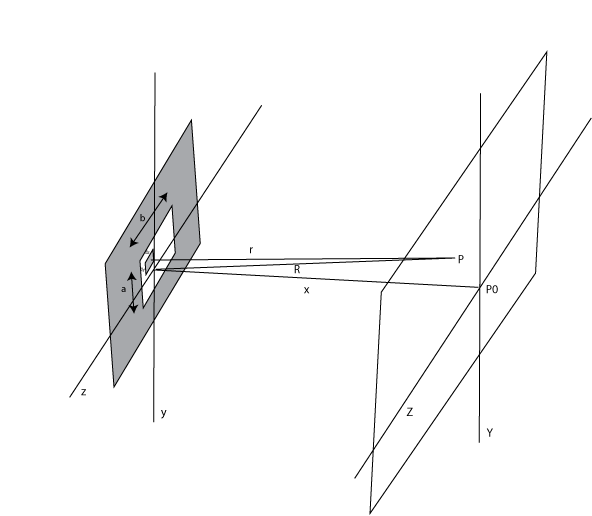The Fourier Transform can be used to represent any well behaved function
f
(
x
)
.
 where
A
(
k
)
=
∫∞
−
∞
f
(
x
)
cos
(
kx
)
ⅆ
x
B
(
k
)
=
∫∞
−
∞
f
(
x
)
sin
(
kx
)
ⅆ
x
I can now substitute for
A
and
B
in the original expression and write:
where
A
(
k
)
=
∫∞
−
∞
f
(
x
)
cos
(
kx
)
ⅆ
x
B
(
k
)
=
∫∞
−
∞
f
(
x
)
sin
(
kx
)
ⅆ
x
I can now substitute for
A
and
B
in the original expression and write:
 and then use
cos
(
x′
−
x
)
=
c
o
s
k
x
cos
k
x′
+
sin
kx
sin
k
x′
and then use
cos
(
x′
−
x
)
=
c
o
s
k
x
cos
k
x′
+
sin
kx
sin
k
x′
 Since the inner integral is an even function we can write
Since the inner integral is an even function we can write
 Now consider the fact that
Now consider the fact that
 because
sin
is an odd function, ie.
∫∞
−
∞
sin
(
k
[
x′
−
x
]
)
ⅆ
k
=
0
So we could have written
because
sin
is an odd function, ie.
∫∞
−
∞
sin
(
k
[
x′
−
x
]
)
ⅆ
k
=
0
So we could have written
 or
or
 or
or
 where
g
(
k
)
=
∫∞
−
∞
f
(
x
)
eikx
ⅆ
x
is the Fourier transform of
f
(
x
)
.
where
g
(
k
)
=
∫∞
−
∞
f
(
x
)
eikx
ⅆ
x
is the Fourier transform of
f
(
x
)
.
Symbolically we write
g
(
k
)
=
Ϝ
{
f
(
x
)
}
f
(
x
)
=
Ϝ
−
1
{
g
(
k
)
}
=
Ϝ
−
1
{
Ϝ
{
f
(
x
)
}
}
Now these concepts are easily extended to two dimensions:
 where
g
(
kx
,
ky
)
=
∫∞
−
∞
∫∞
−
∞
f
(
x
,
y
)
ei
(
x
kx
+
y
ky
)
ⅆ
x
ⅆ
y
.
where
g
(
kx
,
ky
)
=
∫∞
−
∞
∫∞
−
∞
f
(
x
,
y
)
ei
(
x
kx
+
y
ky
)
ⅆ
x
ⅆ
y
.
This tells us is that any nonperiodic function of two variables
f
(
x
,
y
)
can be synthesized from a distribution of plane waves each with amplitude
g
(
kx
,
ky
)
.
Lets consider Fraunhofer diffraction through an aperture again. For example
consider a rectangular aperture as show in the figure. If
 is the source strength per unit area (assumed to be constant over the entire
area in this example) and
dS
=
ⅆ
x
ⅆ
z
is an infinitesmal area at a point in the aperture then we have:
is the source strength per unit area (assumed to be constant over the entire
area in this example) and
dS
=
ⅆ
x
ⅆ
z
is an infinitesmal area at a point in the aperture then we have:
We can define a source strength per unit area

Notice that I flipped the sign in the exponential from what I used in the
earlier lectures on diffraction. This does not change the physics content of
what we are doing in any way, however it allows our notation to follow
standard convention.

If we define
ky
=
k
Y
/
R
and
kz
=
Z
/
R
and we see that

That is, it is equal to the Fourier transform. In fact one can define an
"Aperture Function"
A
(
y
,
z
)
.
Such
that

For a rectangular aperture
 inside the aperture and zero outside it. The aperture function can be much
more complex (literally) allowing for changes in source strength and phase
through the aperture. The resulting E field is the Fourier transform of the
aperture function.
inside the aperture and zero outside it. The aperture function can be much
more complex (literally) allowing for changes in source strength and phase
through the aperture. The resulting E field is the Fourier transform of the
aperture function.


























